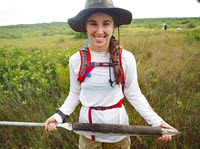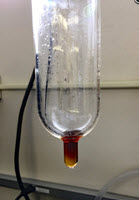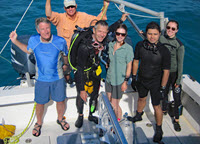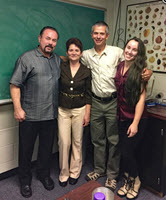
Petroleum hydrocarbons buried in sandy beaches are protected from tides and UV light and, thus, may persist longer in the environment than oil on the beach surface. As a graduate student, Ioana Bociu’s research focused on determining the degradation rates for large sediment-oil clusters buried in Florida beaches following Deepwater Horizon. Her findings will help inform environmental managers about the persistence of buried oil in the environment, which could affect recovery after an oil spill.
Ioana, who recently completed her graduate studies, was a master’s student with the Florida State University Department of Earth, Ocean, and Atmospheric Science. During that time, she was a GoMRI Scholar with the project A Systems Approach to Improve Predictions of Biodegradation and Ecosystem Recovery in Coastal Marine Sediments Impacted by Oil Spill.
Her Path

Growing up in Romania and then the United States, Ioana was curious about and interested in nature and conservation. She began her undergraduate studies at Florida State University with a double-major in International Affairs and Japanese, but felt drawn to environmental issues. She switched her major to Environmental Science and began taking environmental science, geology, and oceanography classes. Her first class with Dr. Jeffrey Chanton got her interested in the carbon cycle and the need for filling gaps in ocean science research. Later on, a class with Dr. Ian MacDonald introduced her to oil biogeochemistry and Ph.D. candidate Brian Wells. She told Wells she wanted to do volunteer laboratory work, and he invited her to assist with his research investigating oil biodegradation in the Gulf of Mexico under Dr. Markus Huettel.
After completing her undergraduate degrees, Ioana conducted field work at the Florida Fish and Wildlife Research Institute for two years, which solidified her passion for carbon cycle research and sparked her desire to pursue graduate school. “When I had the chance of returning to Dr. Huettel’s lab, I was very enthusiastic to begin the GoMRI project as a master’s student,” she said. “I enjoy doing environmental research and learning about natural processes and mechanisms. My drive comes from wanting to understand what is happening in the environment after a long-term disturbance like the Deepwater Horizon oil blowout.”
Her Work

Shortly after the oil spill, the Huettel team conducted an experiment using 100 round metal tea infusers filled with homogenized, weathered oil-sand mixtures (agglomerates) collected from Florida beaches. They buried the agglomerates in Florida beaches in sets of ten in sand at 10-50 cm depth at 10-cm intervals, retrieved the agglomerates at pre-determined intervals over 3 years, and then froze the samples until analysis.
Ioana’s team analyzed the agglomerates for weight loss and change in diameter, which could indicate microbial biodegradation of the oil. A noticeable change in the agglomerates’ color over time prompted Ioana and her team to conduct a color and fluorescence analysis. They applied an elemental analyzer coupled to an isotope ratio mass spectrometer to evaluate temporal changes in carbon content and carbon type (stable isotopes) in the agglomerates. Using a gas chromatograph coupled to a gas mass spectrometer, the team assessed temporal changes in the samples’ petroleum hydrocarbon compositions. Because environmental samples can contain thousands of compounds, Ioana and her team focused only on hydrocarbons considered harmful to humans by the Environmental Protection Agency and the International Agency of Research on Cancer. In total, her team evaluated 30 saturated hydrocarbons and 33 polycyclic aromatic hydrocarbons (PAHs).
Based on these analyses, Ioana estimated that the golf-ball-sized aggregates buried in beach sands would degrade within 3 decades. She further observed that the half-lives (the time required for a quantity to reduce to half its initial value) of saturated hydrocarbons varied between 100 – 568 days and correlated to carbon chain length, with longer (heavier) carbon chains degrading more slowly than shorter carbon chains. The half-lives of PAHs varied between 94 – 836 days, depending on the compound. In comparison, reference agglomerates kept in the dark for approximately 7.4 years without sediment exposure degraded three-times more slowly than agglomerates buried in situ.

“The most critical part of our study is understanding the rate of degradation of buried oiled material, as most studies address oil degradation only in surface sediments. Buried material can persist for longer periods,” explained Ioana. “The more we can learn about what is going on in the environment, the better prepared we can be in the future. A significant part of my motivation comes from wanting to help resolve future issues by providing useful information to the greater public.”
Her Learning
Working in Huettel’s lab had a significant impact on Ioana’s growth as a scientist. Analyzing sediment-oil agglomerates involved a sophisticated extraction and measuring process that required a team effort to complete. This teamwork taught Ioana how to effectively interact with other researchers. She also gained leadership experience while teaching undergraduate students involved with the oil extraction process about the procedures and problem-solving techniques. Ioana’s conversations with Dr. Huettel had a great impact on her growth as a researcher, “Dr. Huettel was very patient with me, as there were quite a few times I walked into his office with a nervous laugh, struggling with something. I realized that verbalizing what I was thinking helped a lot in solving the issues I had. From brief conversations with him, I was able to proceed with the task at hand.”

Presenting her research at the 2018 Gulf of Mexico Oil Spill and Ecosystem Science conference was an especially memorable experience for Ioana. Although she initially felt intimidated by the many experienced researchers present, she found that the conference community was extremely supportive and provided helpful feedback, leaving her feeling revitalized and ready to tackle the next steps of her master’s work.
Her Future
Ioana completed her master’s degree in spring 2018 and is searching for a government agency position conducting research on coastal or carbon cycle topics, broadening her experience and becoming a well-rounded scientist. She said that science students should consider the direction they want to go and the sacrifices they are willing to make at every step of their career. “There will be monotonous days when you have to redo samples or go through large batches of data, but in my opinion the reward of having data that can tell us something we didn’t know about Earth really pays off,” said Ioana. “As with everything in life, there are pros and cons – you just have to learn to find happiness in your choices.”
Praise for Ioana

Dr. Huettel praised Ioana’s enthusiasm and motivation, stating that her attitude had an immediate and positive affect on everyone in his lab. He said that Ioana optimized the hydrocarbon extraction line beyond factory-specified efficiency and became the lab’s expert in running the GC-MS. He explained that she kept a cool head throughout the group’s research and impressed him with her ability to evaluate the complex data sets produced by the GC-MS, despite frequent software crashes. “I guess she could eliminate any research frustration as she honed her aerialist skills while practicing and performing,” he joked.
Huettel noted that when the lab brought on undergraduate students, Ioana became their dedicated supervisor. “It was great to see how, even at this early stage of her career, she managed her own lab group, making sure that high-quality standards were maintained, work was completed on time, and that everybody always stayed well-hydrated,” he said. “She is a born leader, fun to work with, and a role model for her peers.”
The GoMRI community embraces bright and dedicated students like Ioana Bociu and their important contributions. The GoMRI Scholars Program recognizes graduate students whose work focuses on GoMRI-funded projects and builds community for the next generation of ocean science professionals.
By Stephanie Ellis and Nilde Maggie Dannreuther. Contact sellis@ngi.msstate.edu for questions or comments.
************
The Gulf of Mexico Research Initiative (GoMRI) is a 10-year independent research program established to study the effect, and the potential associated impact, of hydrocarbon releases on the environment and public health, as well as to develop improved spill mitigation, oil detection, characterization and remediation technologies. An independent and academic 20-member Research Board makes the funding and research direction decisions to ensure the intellectual quality, effectiveness and academic independence of the GoMRI research. All research data, findings and publications will be made publicly available. The program was established through a $500 million financial commitment from BP. For more information, visit https://gulfresearchinitiative.org/.
© Copyright 2010-2019 Gulf of Mexico Research Initiative (GoMRI) – All Rights Reserved. Redistribution is encouraged with acknowledgement to the Gulf of Mexico Research Initiative (GoMRI). Please credit images and/or videos as done in each article. Questions? Contact web-content editor Nilde “Maggie” Dannreuther, Northern Gulf Institute, Mississippi State University (maggied@ngi.msstate.edu).
